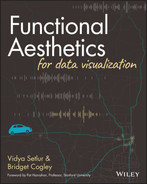Foreword
Data is everywhere. Manipulating data is now considered an essential computer skill, along with searching for information, document editing, and slide making. Spreadsheets are no longer just number-crunching tools; by reading data into a tabular grid, they are now the gateway toward more sophisticated data analysis and graphing. Analyzing and graphing data is taught in high school along with experimental science and analytical reasoning. Solving almost any problem involves data. It is essential to understand your data, to be able to reason about it, and to draw out findings and conclusions. Data-based decision making is becoming a core doctrine of modern businesses and organizations.
How do people interact with data? The answer is obvious. They must be able to see it, as a list, table, map, time series, scatterplot—a visualization. The power of visualization leads naturally to the question of how to present data to people so they can best understand it. This book provides answers to this essential question.
The answers start with how to graph data. Obvious questions are how best to discern different magnitudes or compare values. Is a bar graph better than a pie chart? The next level is how to distinguish categories using color and shape. And how to perceive trends and other patterns. Even basic graphics can benefit from good graphic design. The techniques of graphical design show how to emphasize the most important information and deemphasize the less important. The answers to these questions require that we understand visual perception.
The more interesting questions arise when we think of visualizations as a form of communication. In this view, visualizations are a type of language—a visual language. Now new questions arise. How do we assign meaning to what we see? What do icons and colors mean, what do they represent and symbolize? These types of questions give us a deeper understanding of how visualizations work. A visualization is no longer a simple graph of data. A visualization contains a message; it tries to communicate information to us. We can use it as a form of rhetoric to spur people to action. At the next level, how do we interact with our data using visualizations? How can they be used to help us think? How can we have a dialog with our data?
This book by Vidya and Bridget takes you on this journey. It provides insight into how we see, interpret, understand, and reason about data. The book provides a summary of research findings and useful advice for the practitioner. It will enable you to use visualizations more effectively as you analyze data and communicate what you found to the people around you.
Pat Hanrahan
